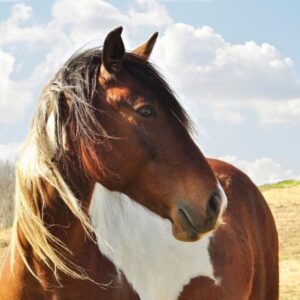 Armed with a battery of premolars and molars on each quadrant of the skull, horses with sound dentition process forage efficiently. Also called cheek teeth, the premolars and molars pulverize forages, increasing the surface area of the forage particles and allowing the most nutrients to be extracted from them as they flow through the gastrointestinal tract. When horses age, dental diseases crop up more frequently. As horses creep toward and into their 20s, molars begin to wobble in their sockets and eventually fall out. Special consideration must be given to meeting forage requirements when this happens.
Armed with a battery of premolars and molars on each quadrant of the skull, horses with sound dentition process forage efficiently. Also called cheek teeth, the premolars and molars pulverize forages, increasing the surface area of the forage particles and allowing the most nutrients to be extracted from them as they flow through the gastrointestinal tract. When horses age, dental diseases crop up more frequently. As horses creep toward and into their 20s, molars begin to wobble in their sockets and eventually fall out. Special consideration must be given to meeting forage requirements when this happens.
In healthy horses with normal dentition, forage can be offered in numerous ways, as pasture, traditional long-stem hay, chaff, hay cubes, hay pellets, and haylage. For aged horses with mild dental disease, leafy high-quality hay or immature pasture grasses of moderate length can be offered. When more advanced dental disease sets in, such as the loss of molars, horses will begin to quid when offered these same forages.
What is Quidding?
During quidding, horses roll long-stemmed forages into a ball and then drop them from the mouth, instead of chewing and swallowing normally.
“No harm lies in allowing aged horses to quid as long as they do not try to swallow the boluses of forage. Through trial and error, most horses figure out how to quid safely,” explained Kathleen Crandell, Ph.D., a nutritionist for Kentucky Equine Research. “Quidding may relieve boredom in horses that are likely not as active as they once were, and provides horses with valuable ‘chew time.’”
Crandell mentioned another benefit to quidding. “With quidding, the forage bolus is coated with saliva or oftentimes moistened as horses drink. When moisture is added, a ‘hay tea’ is made within the mouth, and horses may be able to leach some nutrients from the forage.”
Quidding provides few, if any, actual calories to the horse. So, source and prepare appropriate forages in a way that the horse derives the most benefit.
Forage Recommendations
Hay cubes, soaked:
For horses with poor teeth, hay cubes are the most common alternative forage. When traditional hay is unsuitable, owners figure cubes may be the best substitute. If horses cannot chew the hay cubes adequately, there is little value in the cubes because horses cannot digest them. Crandell, who has managed many old horses, breaks apart the cubes after soaking them, as some of her horses with poor teeth have refused full-sized cubes that would be difficult to chew, even when soaked.
Hay pellets, soaked:
For horses that hold their weight well, owners should look for pellets made from grasses, like timothy, Bermudagrass, or teff. Alfalfa pellets would be appropriate for horses that have a harder time maintaining body condition, as they contain more calories. “Pellets should soak long enough to fall apart completely,” Crandell explained. “I soak alfalfa pellets until they become a soft mush, usually one or two hours. The amount of water used to soak the pellets determines the heaviness of the mush. If there isn’t enough water, the centers of the pellets will remain hard and be problematic for some horses.”
Beet pulp, soaked.
As a super fiber, beet pulp contains more calories than equal amounts of hay. “I prefer to combine beet pulp with hay pellets. Hay is a more nutritionally balanced fiber source than beet pulp,” Crandell explained. You can purchase beet pulp as shreds (molassed or unmolassed), pellets, or micronized flakes. Soak shreds/pellets for an hour if using cold water and a half-hour with hot water for aged horses. Micronized beet pulp soaks up water quickly and is often ready to feed in 10-15 minutes.
Chaff or chopped forage, soaked.
Depending on the country of origin, chaff can range from 1-3 cm in length. The shorter chaff may be somewhat easier to chew, but it won’t improve the digestibility.
Commercial senior feeds, soaked.
Quite often, senior feeds are sold as complete feeds. However, Crandell recommends adding additional fiber to senior feeds. Add-ins may include beet pulp or hay pellets.
Further Recommendations
Soaking forages makes them easier to chew for horses with dental problems. Soaking increases the volume of some of these forage products and creates larger meals. Due to this, several small meals a day may be necessary to mimic natural feeding patterns.
Aged horses fed diets composed exclusively of forage should be fed a balancer pellet. Balancer pellets provide protein, vitamins, and minerals often deficient in forage-only diets. If alfalfa makes up a large part of the diet, a balancer pellet may not be necessary, but a high-quality vitamin and mineral supplement will be.
Read the original article at Kentucky Equine Research.